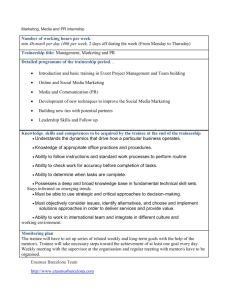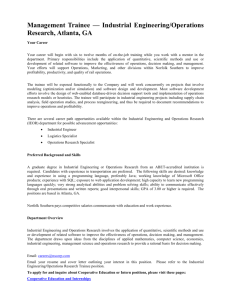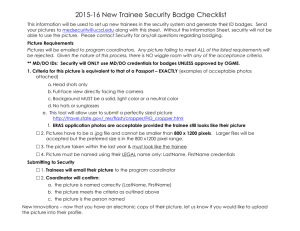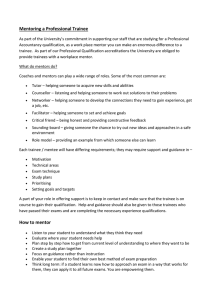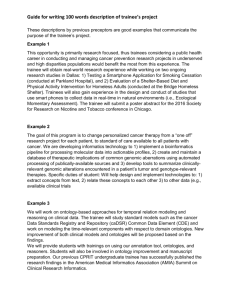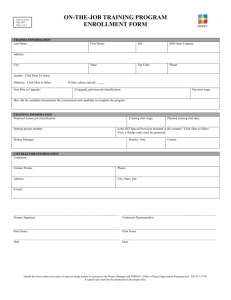Developing-the-Training-Plan-and-On-going-assessment
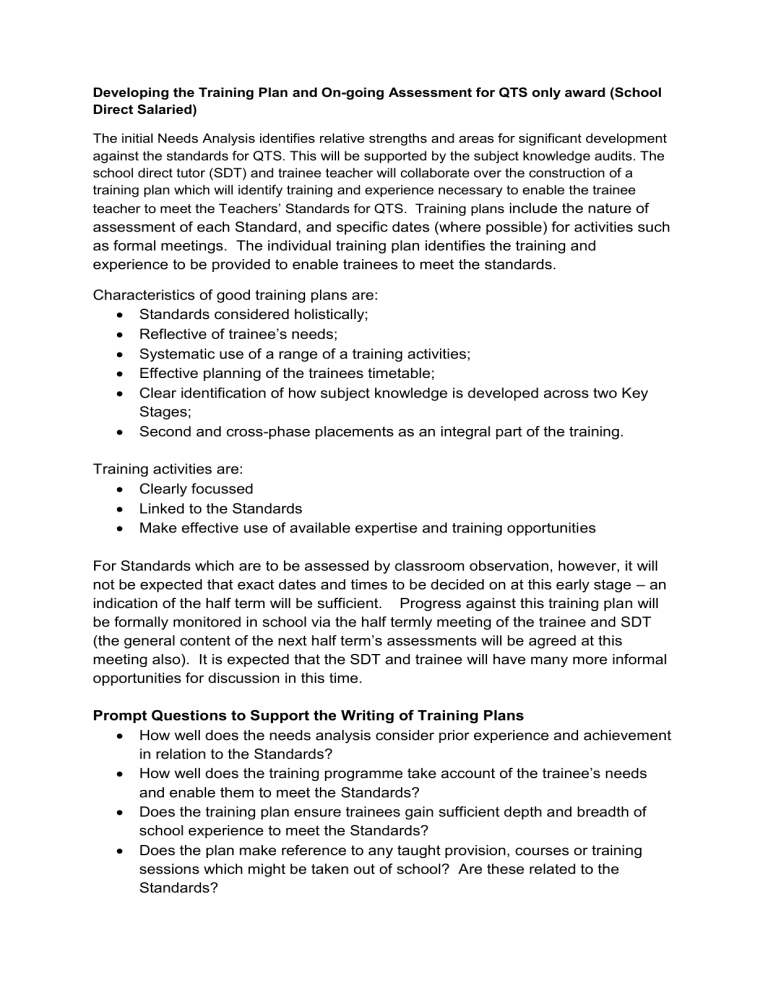
Developing the Training Plan and On-going Assessment for QTS only award (School
Direct Salaried)
The initial Needs Analysis identifies relative strengths and areas for significant development against the standards for QTS. This will be supported by the subject knowledge audits. The school direct tutor (SDT) and trainee teacher will collaborate over the construction of a training plan which will identify training and experience necessary to enable the trainee teacher to meet the Teachers’ Standards for QTS. Training plans include the nature of assessment of each Standard, and specific dates (where possible) for activities such as formal meetings. The individual training plan identifies the training and experience to be provided to enable trainees to meet the standards.
Characteristics of good training plans are:
Standards considered holistically;
Reflective of trainee’s needs;
Systematic use of a range of a training activities;
Effective planning of the trainees timetable;
Clear identification of how subject knowledge is developed across two Key
Stages;
Second and cross-phase placements as an integral part of the training.
Training activities are:
Clearly focussed
Linked to the Standards
Make effective use of available expertise and training opportunities
For Standards which are to be assessed by classroom observation, however, it will not be expected that exact dates and times to be decided on at this early stage – an indication of the half term will be sufficient. Progress against this training plan will be formally monitored in school via the half termly meeting of the trainee and SDT
(the general content of the next half term’s assessments will be agreed at this meeting also). It is expected that the SDT and trainee will have many more informal opportunities for discussion in this time.
Prompt Questions to Support the Writing of Training Plans
How well does the needs analysis consider prior experience and achievement in relation to the Standards?
How well does the training programme take account of the trainee’s needs and enable them to meet the Standards?
Does the training plan ensure trainees gain sufficient depth and breadth of school experience to meet the Standards?
Does the plan make reference to any taught provision, courses or training sessions which might be taken out of school? Are these related to the
Standards?
Does the training plan include the areas outlined for EPS (NB the school takes responsibility for ensuring that the trainee develops knowledge and understanding of the areas not covered through University based sesisons)
Is the second school placement considered as an integral part of the training plan with explicit training needs identified?
Does the plan consider the trainee’s subject knowledge (including ICT) and how identified weaknesses will be addressed?
Does the training plan consider how subject knowledge for two key stages will be addressed?
Does the design of the plan provide systematic coverage of two consecutive key stages?
In primary phase training plans, is the development of a range of core and non-core subjects in teaching, training, subject knowledge development and assessment considered in ways that directly link to the QTS Standards?
Does the plan reflect the holistic nature of the Standards
– are they organised in the training plans as outcome statements?
Are the training activities clearly focussed, linked to the Standards and designed to make effective use of available expertise and training opportunities?
REVIEWING ITPs
Trainee teacher name:
Prompt Question
How accurately have the trainee’s needs been analysed?
How fully did the analysis take account of the trainee’s prior experience and achievement in relation to the Standards?
How well is the training programme designed to take account of the trainee’s needs?
Training activities
Does the ITP systematically use a range of training
Activities?
Are training activities clearly focussed and linked to the
Standards?
Does the training plan include areas outlined for professional studies
Does the plan make reference to any courses or training sessions which might take place out of school?
Does the plan provide systematic coverage of two key stages?
Subject Knowledge
Does the plan consider the trainee’s subject knowledge including (ICT) and how identified weaknesses will be addressed?
Is there clear evidence of how subject knowledge is developed across two adjacent stages e.g. are training activities provided for secondary trainees to gain understanding of their specialist subject is KS2 and how to build on this prior experience when pupils enter KS3 ?
Do primary trainees have opportunities to gain knowledge and understanding of the curriculum expectations in KS3?
Second Placement
Is the second school placement seen as an integral part of the training with explicit training needs identified?
Evaluation
SDT Name:
How does this aspect of the ITP need to be developed?
o o o o o o o
Nature of On-going Assessment :
Classroom observation is a major method of assessing competence against the Teachers’
Standards. Most observations will be carried out by school mentors although other qualified teachers may assist in this role. All paperwork relating to classroom observations are to be shared between the trainee teacher and the school mentor. A record of observations will be kept by the school mentor. At each feedback meeting the training plan will be discussed, amended and progress recorded.
Certain Teachers’ Standards may not be achieved by classroom observation alone but by other training activities equivalent to 60 days of training such as:
Taught sessions for groups of trainees
School based INSET
Assignments and tasks
Team- teaching and joint planning
Observation and discussion of practice
Meetings with mentors and subsequent discussion and analysis and,
Training in venues other than schools
On-going Assessment Informing the Training Plan
After each classroom observation feedback session it should be expected that the targets for the following observation will be agreed and that progress in achieving the Teachers’
Standards will be consistent. It will be the responsibility of the mentor to check that progress is being made against the schedule agreed on the training plan.
Responsibility for data collection
The mentor will be responsible for monitoring the progress of the trainee teacher’s training plan, including the verification that Teache rs’ Standards have been met. The lead school mentor will be responsible for overseeing all trainee teachers and their mentors and will monitor via half termly meetings that consistency and rigour is being applied in the process.
Role of the University School Direct Link tutor (SDL)
There will be three joint observations of teaching along with a scrutiny of documentation and the writing of a report. This will happen during: November, March and June/July. The final meeting will be an assessment event which will determine the verification of recommendation for the award of QTS. There is the possibility of a visit from an external examiner.
If relevant, and working with the SDL, the lead school mentor will undertake one joint observation with the school mentor in place of one of the University/ school mentor joint observations.
At the review meeting the:
- SDL and SDM will review the trainee teacher’s progress
-
The SDL will sample the trainee’s evidence
Termly Assessment
The school will submit a termly report to the University on each trainee teacher that will indicate their progress in achieving the T eachers’ Standards. Classroom observations and mentoring will be important components of this training programme. At each stage the reports will be required to identify whether the trainee is:
1)
Meets the Teachers’ Standards at an ‘Outstanding’ level for the stage of professional development
2) Meets the Teachers’ Standards at a ‘Good’ level for the stage of professional development
3) ‘Requires Improvements to be Good’ at meeting the Teachers’ Standards for the stage of professional development
4) Inadequate
Award of QTS :
The award of QTS (Qualified Teacher Status) is therefore assessed on an on-going basis through the completion of:
3 termly assessments with evidence recorded on an assessment form
Compilation of a portfolio of evidence
Completion of a training plan updated on a termly basis
Completion of an assignment
Attendance at school based training activities
Achievement of all Teachers’ Standards
Assignment:
During the second term an assignment will be required to be submitted. The assignment should be submitted to the school mentor after May half term
The purpose of the case study is to enable students to focus on one child’s learning in depth and to identify his/her strengths and areas for development. This should then be used to meet the child’s individual needs as a learner through setting appropriate targets for learning, tracking progress towards these targets and accounting for the impact of students’ teaching.
Impact on child’s attainment (outcomes)
This child should have additional needs e.g. a child with an IEP, a child with a disability, a child with SEN that has not yet been identified as needing an IEP, a child identified as EAL or a child with emotional and/or behaviour difficulties. When discussing this with the mentor and/or class teacher, consideration should be given to selecting a child who would benefit most from a case study focus. In some circumstances, it may be helpful to select more than one child e.g. where there is a small group of children (2-3), whose learning is affected by their reluctance to write. When choosing a child (or children) it is important to ensure that he or she is in the class for the majority of lessons.
(see appendices for further details)
Assignment Appendices
School Direct Salaried (QTS)
Assignment at LEVEL 6 (equivalent)
Level 6: 2,000 word (equivalent) essay assessed on a pass/fail basis, to be submitted to the SDT after May half term 2014.
A Case Study of a child’s learning who has additional needs.
Trainees are required to:
Identify a child with additional needs
Observe the chosen child and her/his learning in depth
Keep observational records in order to evaluate the child’s strengths and developments
Suggest/provide appropriate targets/next steps
Examine and reflect on theoretical perspectives and implications for practice
The assignment requires students to use their detailed records on one child and to write up observations and to write a report on the child using the school’s format.
Word limit: 2000 words in total (observations and report)
Department of Primary Education
Trainee Name:
School Direct QTS LEVEL 6
Level 6: 4,000 word essay assessed on a pass/fail basis, to be submitted to the
SDT after May half term
Students should demonstrate their ability to;
Criteria for assessment critically review child’s learning via observations
Write an appropriate report write clearly and coherently in SE and reference appropriately
Commentary
What the student needs to do to improve
Result: SD Tutor: Date:
CASE STUDY: ASSIGNMENT MARKING CRITERIA GUIDANCE: LEVEL 6
Criteria Excellent (70%+) critically review child’s learning via observations
Write an appropriate report
Clear and coherent presentation and use of standard
English and reference appropriately
A wide range of observations and other sources is evidenced to support arguments and different perspectives.
Critical analysis of the literature justifies views and arguments.
The consideration of the role of observation is robust and convincing.
The assignment provides strong and consistent evidence of target setting measures. It makes good use of external support e.g. speech therapy demonstrating a collaborative process.
The assignment and its arguments are clear and effectively structured. The written English is of a high standard in style and content.
Very Good / Good
(60%+)
A range of observations and other sources is used with careful scrutiny.
Alternative views are discussed . The focus on the role of observations is secure and readings are used to support insight and argument.
The assignment provides consistent evidence of target setting measures. It makes good use of external support e.g. speech therapy demonstrating a collaborative process.
The assignment is well structured with clear and structured arguments. The work observes standard
English.
Sound (50%+)
Observations demonstrate an understanding of the key issues. The selection of material related (e.g. discussions, other colleagues’ support) is appropriate.
Beginning to include reference to appropriate texts.
The assignment provides evidence of target setting with basic measures of time constraints, measurability and realism.
The assignment is coherently structured and is accessible to the reader. The work observes most aspects of standard
English.
Insufficient Evidence 1
(40%+)
Some reference is made to observations; it is limited in nature and draws on a restricted number. There is some evidence that the observations have helped to inform thinking.
There is sufficient consideration of the role of observation throughout the work.
The assignment provides some evidence of target setting. It uses description to provide a context for discussion.
The assignment has some structure. A few minor errors appear in the use of standard
English (possibly due to poor proof reading).
Insufficient Evidence 2
(30%+)
There is a failure to engage with the observations , there is little evidence that they have been understood.
It is a predominantly descriptive account.
The assignment does not show a coherent structure or a sense of direction. It is hampered by errors in standard English.
Unacceptable (-29%)
There is a lack of evidence of engagement
It is a purely descriptive account.
The assignment lacks structure and a sense of direction. It includes irrelevant discussion and has a significant number of errors in standard English.
Portfolio
It may be helpful to compile a short portfolio * in order to assist you with your assignment of writing a case study. The following sections are a guide:
Section 1**
Brief details about the child e.g. name, class, teacher
Section 2
Previous school report
Documents relevant to the needs of the child e.g. IEP, Personal Learning Plan
Class tracking data showing the child’s current attainment
Child’s targets (dated)
Section 3
Your observational records (dated)
Other sources of information (dated)
Diary of events
Section 4
School’s report format
Section 5
Any other information
(*) You may wish to store information electronically or capture data in video/photographic form.
(**) You would need to ensure that all information is rated confidentially and that the names of children and teachers have anonymity

